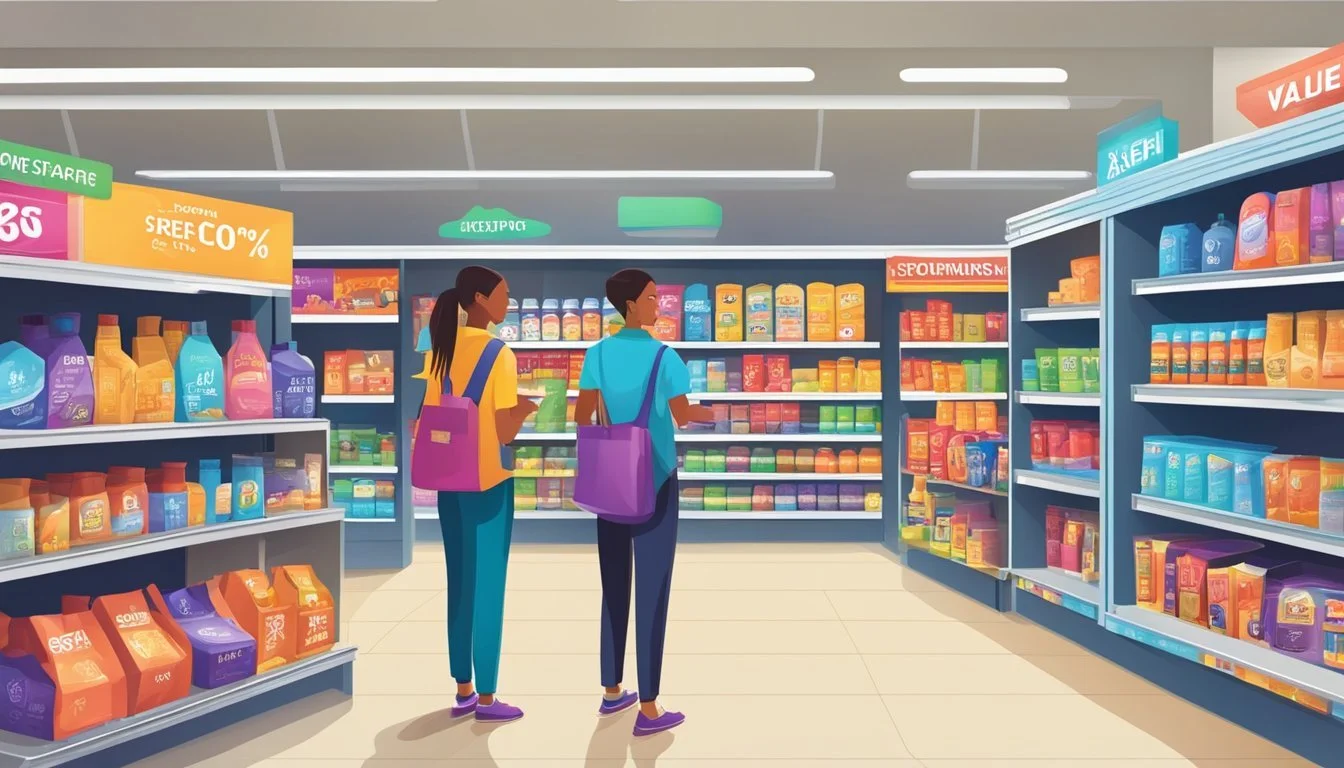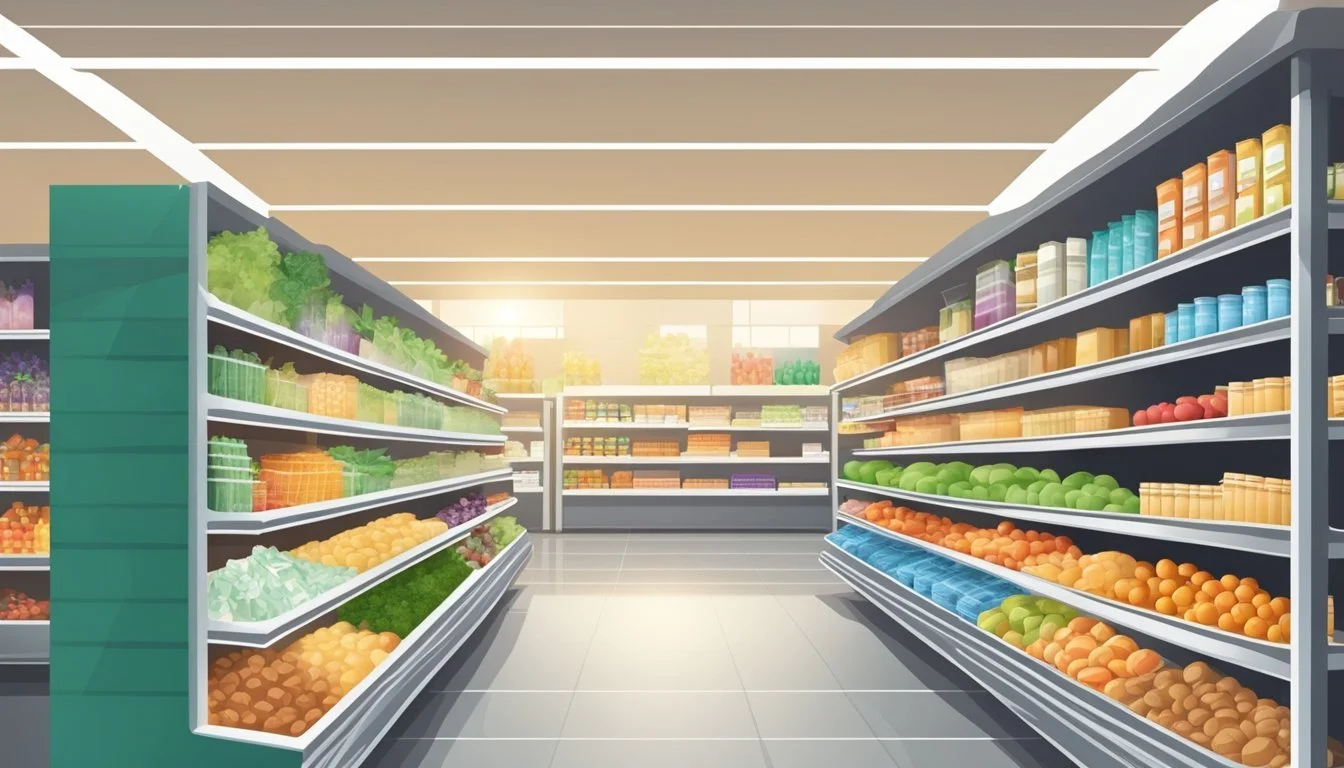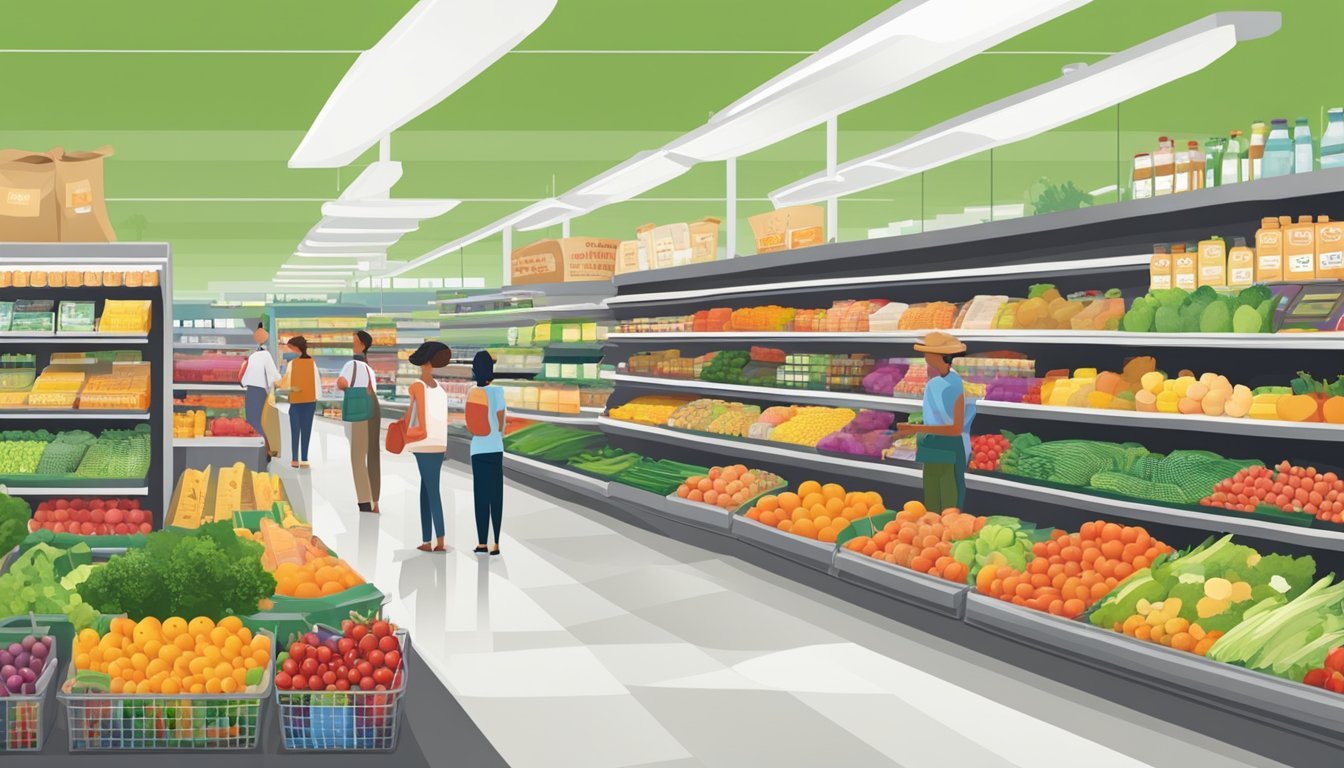Stretching Your Dollar: Unveiling the Best Grocery Stores for Value Shoppers
Grocery shopping can significantly impact household budgets, especially as food prices continue to rise. Finding the most cost-effective supermarket has become a crucial strategy for many consumers looking to stretch their dollars further.
The top grocery stores for value in the U.S. include Aldi, Walmart, Costco, Trader Joe's, and Save A Lot. These chains consistently offer competitive pricing on a wide range of products, helping shoppers save money on their weekly food bills. Each store employs different tactics to keep costs down, such as focusing on private-label products, maintaining smaller store formats, or leveraging bulk-buying power.
Beyond choosing the right store, savvy shoppers can employ additional strategies to maximize savings. Shopping mid-week, using store loyalty programs, and taking advantage of digital coupons are effective ways to reduce grocery expenses. By combining these methods with smart store selection, consumers can significantly lower their food costs without sacrificing quality or variety.
Understanding Grocery Store Pricing
Grocery store pricing involves complex factors that impact consumers' wallets. Food prices fluctuate based on supply, demand, and economic conditions.
The Basics of Food Prices and Inflation
Food prices are influenced by production costs, transportation expenses, and market dynamics. When costs rise, grocers often pass increases to consumers. Inflation plays a key role in driving up food prices over time.
Weather events, crop yields, and global trade policies can cause sudden price spikes. Energy costs affect both food production and distribution, impacting shelf prices. Labor shortages and wage increases in the food industry also contribute to higher grocery bills.
Seasonality affects produce prices, with out-of-season items costing more. Store locations and local competition influence pricing strategies. Some grocers use loss leaders - selling popular items below cost to attract shoppers.
Price Index and Consumer Reports Analysis
The Consumer Price Index (CPI) tracks food price changes over time. It measures inflation by comparing costs of a fixed basket of goods. The food-at-home CPI rose 3.6% in 2023, showing continued grocery inflation.
Consumer Reports conducts regular price comparisons across major grocery chains. Their analysis reveals significant price differences between stores. Discount chains like Aldi and Walmart consistently offer lower prices on staple items.
Regional price variations exist due to local economic factors. Urban areas often have higher grocery prices than rural locations. Store formats impact pricing, with warehouse clubs offering bulk discounts.
Price matching policies and loyalty programs can help consumers save. Unit pricing allows for accurate cost comparisons between brands and sizes. Savvy shoppers can reduce grocery bills by using these tools and shopping strategically.
Strategies for Smart Shopping
Effective grocery shopping requires planning and thoughtful decision-making. A strategic approach can lead to significant savings and more efficient shopping trips.
Creating an Effective Shopping List
A well-crafted shopping list is essential for smart grocery shopping. Start by taking inventory of your pantry and refrigerator. Note items that need replenishing. Organize your list by store layout to save time and reduce impulse purchases.
Consider using a digital list app that syncs across devices. This allows family members to add items as needed. Many apps also offer features like price tracking and coupon integration.
Stick to your list while shopping. This discipline helps avoid unnecessary purchases and keeps your budget on track.
Meal Planning to Reduce Costs
Meal planning is a powerful tool for reducing grocery expenses. Begin by checking store flyers for sales and specials. Plan your meals around these discounted items.
Create a weekly menu that incorporates leftovers and uses similar ingredients across multiple dishes. This approach minimizes waste and ensures efficient use of perishables.
Consider batch cooking and freezing portions for future meals. This strategy can save time and money by allowing bulk purchases of ingredients.
Rotate meal plans to maintain variety while capitalizing on seasonal produce and sales cycles.
Buying in Bulk Versus Single Items
Buying in bulk can lead to savings, but it requires careful consideration. Compare unit prices to determine if bulk purchases offer real value. Look for per-ounce or per-pound pricing on shelf labels.
Bulk buying works best for non-perishable staples and frequently used items. Examples include rice, pasta, and canned goods. For perishables, consider storage space and consumption rates to avoid waste.
Single-item purchases may be more cost-effective for specialty ingredients or items used infrequently. They also allow for greater variety in meals without overcommitting to large quantities.
Balance bulk and single-item purchases based on your household size, storage capacity, and consumption patterns.
Maximizing Savings with Rewards and Loyalty Programs
Grocery store loyalty programs offer significant savings opportunities for shoppers. Free and paid memberships provide exclusive discounts, while strategic use of rewards credit cards can amplify benefits.
Comparing Loyalty Programs Across Stores
Kroger Plus, a free program, saves members an average of $576 annually. It offers exclusive discounts and personalized deals based on shopping habits.
Walmart+ costs $98 per year but includes perks like free delivery and fuel discounts. For frequent Walmart shoppers, this paid membership can provide substantial value.
Target Circle is free to join and offers 1% earnings on purchases. Target Circle 360, at $10.99 monthly, adds unlimited same-day delivery.
Kohl's Rewards gives 5% back on purchases, with additional $10 rewards for birthdays.
When choosing a program, consider:
Frequency of store visits
Types of available discounts
Additional perks like free shipping
Best Practices for Using Grocery Rewards Credit Cards
Grocery rewards credit cards can enhance savings when used responsibly. Look for cards offering high cashback rates on grocery purchases, typically 3-6%.
Key strategies:
Pay off balances in full to avoid interest charges
Use the card exclusively for grocery spending
Stack credit card rewards with store loyalty programs
Some cards offer rotating categories with higher rewards. Plan major grocery purchases during these periods for maximum benefits.
Be aware of annual fees. Choose a card that aligns with your spending habits to ensure the rewards outweigh any costs.
Remember to review your rewards periodically. Some points or cashback may expire if not used within a certain timeframe.
Utilizing Coupons and Deals Effectively
Strategic use of coupons and deals can significantly reduce grocery costs. Savvy shoppers employ various methods to find discounts and maximize savings on everyday purchases.
How to Find and Organize Coupons
Coupons are available from numerous sources. Sunday newspaper inserts remain a popular option, offering manufacturer coupons for a wide range of products. Store circulars provide weekly deals and store-specific coupons.
Many grocery chains now offer digital coupons through their websites or mobile apps. These can be easily loaded onto store loyalty cards for automatic savings at checkout.
Organizing coupons is crucial for effective use. Some shoppers prefer physical coupon binders with categorized sections. Others opt for digital organization using spreadsheets or specialized coupon apps.
Expiration dates should be clearly marked to ensure timely use. Regularly reviewing and purging expired coupons keeps the collection manageable and up-to-date.
Leveraging Apps and Online Resources for Deals
Mobile apps have revolutionized the couponing landscape. Ibotta and Checkout 51 offer cash back on specific items after purchase. Users simply upload receipts to claim rewards.
Many stores have their own apps featuring exclusive deals and personalized offers based on shopping history. These often include electronic coupons that can be activated with a single tap.
Websites like The Krazy Coupon Lady aggregate deals from various retailers, helping shoppers plan purchases around the best discounts. Some sites also offer printable coupons for in-store use.
Combining multiple savings methods, such as store sales, manufacturer coupons, and cash-back apps, can lead to significant discounts. This strategy, known as "stacking," maximizes savings on each purchase.
Exploring Discount Retailers and Store Brands
Discount grocery retailers and store brands offer significant savings opportunities for budget-conscious shoppers. These options provide quality products at lower prices compared to traditional supermarkets and name brands.
A Comparison of Discount Retailers and Their Pricing
Aldi and Lidl stand out as leading discount grocery chains, known for their no-frills approach and competitive pricing. Both stores focus on a limited selection of items, primarily their own brands, to keep costs down.
Grocery Outlet offers a unique model, selling overstock and closeout items at deeply discounted prices. This approach provides shoppers with ever-changing deals on name-brand products.
WinCo Foods, a employee-owned company, competes on price through bulk bins and a large selection of store-brand items. Their low-cost model includes having customers bag their own groceries.
Costco, while requiring a membership fee, provides bulk purchasing options that can result in significant savings for larger households or those able to store larger quantities.
Advantages of Choosing Store-Brand Items
Store brands, also known as private label products, offer substantial savings compared to national brands. Kroger's Simple Truth and Whole Foods' 365 Everyday Value provide organic and natural options at lower price points.
Many store-brand items are produced by the same manufacturers as national brands, ensuring similar quality. Blind taste tests often show consumers unable to distinguish between store and name brands.
Store brands allow retailers like Wegmans to offer premium products at more accessible prices. These items typically provide savings of 20-30% compared to equivalent national brands.
By focusing on store brands, shoppers can reduce their grocery bills without sacrificing quality. This strategy is particularly effective at discount chains where store brands make up a larger portion of the product selection.
Convenience and Savings with Online Shopping and Delivery
Online grocery shopping and delivery services offer time-saving convenience and potential cost savings. Comparing options and leveraging membership perks can help maximize value.
Choosing Between Grocery Delivery Services
Instacart partners with local stores to offer same-day delivery in many areas. The service charges delivery fees and markups on some items. Amazon Prime members can access free grocery delivery through Amazon Fresh in select locations.
Walmart+ provides unlimited free delivery on orders over $35. Target offers same-day delivery via Shipt with a membership or per-order fee. Regional chains like Kroger and Albertsons have their own delivery services in certain markets.
When selecting a service, consider delivery fees, item pricing, and minimum order requirements. Many offer free trials or discounts for new customers to test the experience.
Balancing Cost and Convenience with Online Shopping
Online ordering saves time but may come at a premium. Compare prices across services and against in-store costs. Look for digital coupons and promotions to offset fees.
Bulk ordering through services like Boxed can yield savings on pantry staples and household goods. Subscription options for frequently purchased items often provide discounts.
Planning larger orders to meet free shipping thresholds helps maximize value. Some services offer pickup options to avoid delivery fees while still providing the convenience of online ordering.
Loyalty programs and credit card rewards can provide additional savings on online grocery purchases. Carefully review terms to understand how points or cashback accrue on these transactions.
Additional Tips for Saving Money on Groceries
Smart shopping strategies and digital tools can significantly reduce grocery expenses. These approaches focus on minimizing waste and maximizing rewards.
Reducing Food Waste and Grocery Bill
Plan meals in advance to avoid overbuying. Create a detailed shopping list and stick to it. This prevents impulse purchases and reduces food waste.
Store food properly to extend its shelf life. Use airtight containers for dry goods and proper storage techniques for fruits and vegetables.
Freeze leftovers or excess ingredients for future use. This prevents spoilage and provides quick meal options.
Buy in bulk for non-perishable items and frequently used products. Compare unit prices to ensure bulk purchases offer genuine savings.
Check expiration dates carefully. Choose items with longer shelf lives to minimize waste. Use older items first to prevent spoilage.
Cash Back Apps and Their Benefits
Download popular cash back apps like Ibotta, Fetch Rewards, or Checkout 51. These apps offer rebates on specific products or entire grocery trips.
Scan receipts after each shopping trip to earn points or cash back. Some apps provide bonuses for consistent use or reaching certain spending thresholds.
Look for special promotions or bonus offers within the apps. These can significantly boost savings on regular purchases.
Compare offers across multiple apps to maximize rewards. Some apps allow stacking of rewards with store loyalty programs or coupons.
Cash out rewards regularly to ensure you benefit from your savings. Most apps offer various redemption options, including gift cards or direct bank transfers.
The Role of Cleanliness and Store Experience
A clean, well-maintained grocery store environment directly impacts customer satisfaction and spending habits. Shoppers tend to perceive tidy stores as offering better value and quality products.
The Impact of Cleanliness on Price Competitiveness
Clean stores often enjoy a competitive edge in pricing. Customers are willing to pay slightly more for groceries in a hygienic environment. This perception of value allows stores to maintain competitive prices while still commanding a premium.
Spotless aisles and organized shelves create an impression of freshness and quality. Shoppers associate cleanliness with proper food handling and storage practices. This trust leads to increased purchases, especially for perishable items.
Tidy stores also reduce perceived wait times. Customers feel more comfortable browsing and tend to spend more time in clean spaces. This extended shopping duration often results in larger basket sizes and higher overall sales.
Cleanliness impacts operational efficiency too. Well-organized stores require less staff time for maintenance, allowing more focus on customer service. This efficiency can help keep prices competitive by reducing labor costs.
Emerging Trends in Grocery Shopping
The grocery landscape is evolving rapidly, with new shopping formats and technologies reshaping consumer experiences. These changes are altering how people buy groceries and what they expect from retailers.
The Rise of Warehouse Clubs and Specialty Stores
Warehouse clubs like Costco and Sam's Club are gaining popularity among cost-conscious shoppers. These stores offer bulk purchases at discounted prices, appealing to families and individuals looking to save money on groceries.
Specialty stores focusing on niche markets, such as organic products or international foods, are also on the rise. These retailers cater to specific dietary preferences and cultural tastes.
Market Basket stands out for its no-frills approach and low prices, attracting customers who prioritize value. Tops markets have adapted by emphasizing fresh produce and local products to compete with larger chains.
Technological Advancements and Their Effects on Shopping
Grocery technology is transforming the shopping experience. Mobile apps now allow customers to create shopping lists, access digital coupons, and even scan items as they shop.
Curbside pickup has become increasingly popular, especially since 2020. Shoppers can order online and collect their groceries without entering the store, saving time and effort.
AI-powered systems are enhancing personalization in grocery shopping. These tools analyze purchase history to suggest products and tailor promotions to individual preferences.
Self-checkout kiosks and cashier-less stores are becoming more common, reducing wait times and labor costs for retailers. Some stores are even experimenting with robotic assistants to help customers find items.





